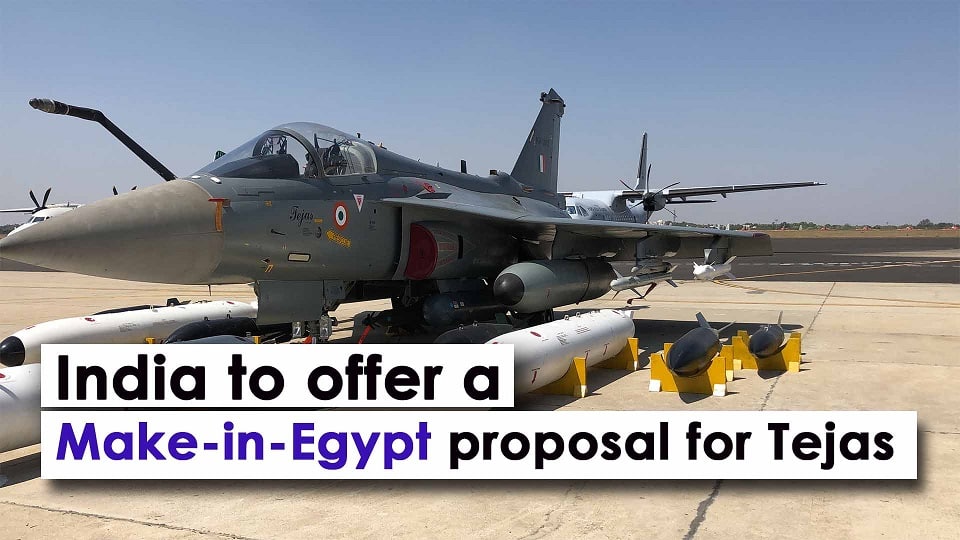Aerospace
India to offer a make-in-Egypt proposal for 70 Tejas planes?

The Indian Tejas is roaring high in capacity and power, and now HAL is attempting to offer a Tejas fighter aircraft deal to Egypt. It also intends to establish production facilities in Egypt for the manufacture of light combat aircraft (LCA) and helicopters as it seeks export prospects in the Middle East and North Africa region. Egypt is looking for a fleet of 70 aircraft in the LIFT category.
According to reports, the Egyptian Air Force head is scheduled to visit India in the coming days to inspect manufacturing and maintenance facilities.
Egypt is primarily interested in being the first to market with a fighter training aircraft variant based on the Tejas trainer airframe. The airframe will be stripped of high-end sensors and avionics but will incorporate training-specific cockpit equipment like as a Wide Area Display (WAD) to be utilized as an Advance Jet Trainer for inexperienced pilots before they move to Squadrons. The LIFT category aircraft assists pilots in becoming qualified before flying other fighters such as the Sukhoi 30 MKI, Rafale, or F16 fighter aircraft. The LIFT category aircraft is used for both training and combat purposes.
It boasts the most powerful air force fleet among emerging countries. Egypt’s air force has a mixed fleet of aircraft from China, Russia, the United States, and Europe, and it has recently placed orders for French Rafael fighters and Russian 35 fighters. It currently has approximately 220 f 16 fighters, 24 rafale, 15 mriage, and 46 mig 29 fighters.
HAL has the option of pushing the HTT 40 Hindustan Turbo Trainer aircraft, although this is still in the works. However, it will be advantageous to obtain a starting level trainer aircraft. HAL is contemplating an initial programme similar to the US Air Force’s T-X programme for a new-generation trainer aircraft produced by the SAAB-Boeing collaboration.
HAL is working hard to increase the number of export orders for TEJAS, and it confidently displayed the aircraft flying display in the Dubai and Singapore airshows. The aircraft is built on a sturdy airframe that has undergone extensive testing and has good avionics support. Tejas is now being upgraded to the Mark2 level for the Indian Air Force, which includes the latest avionics and weapon deployment capabilities.
The Royal Malaysian Air Force (RMAF) is the most promising potential customer, having bid for 18 light fighters with an option for another 18. This would be a welcome first export order for the Tejas.
HAL has provided the RMAF with the advanced Tejas Mark 1A fighter, which includes mid-air refueling, an AESA radar, electronic warfare (EW) capability, and the capacity to shoot BVR missiles. HAL is undergoing testing for the Malaysian-specified on-board oxygen generating system (OBOGS).
There is a considerable possibility that Tejas will outperform the other fighter capabilities and win the contract from Malaysia, but its government purchasing agency has yet to make a decision.

Aerospace
Boeing Transfers Rocket Stage to NASA, Paving Way for Human Moon Mission

Boeing has achieved a significant milestone by providing NASA with the second core stage of the Space Launch System (SLS) rocket.
This crucial component, crafted at NASA’s Michoud Assembly Facility (MAF), is set to propel the Artemis II crew into lunar orbit, marking humanity’s return to deep space after a 50-year hiatus.
The monumental Boeing-built rocket stage, the largest element of the Artemis II mission, will embark on a journey aboard the Pegasus barge, traveling 900 miles to NASA’s Kennedy Space Center.
Comparison of two legendary aircraft B777x vs B747 aircraft:Click here
Upon arrival, it will be meticulously integrated with other essential Artemis II components, including the upper stage, solid rocket boosters, and NASA’s Orion spacecraft within the iconic Vehicle Assembly Building. This intricate integration process is a vital step toward the eagerly anticipated Artemis II launch, slated for 2025.
“Boeing-built products helped land humankind on the moon in 1969, and we’re proud to continue that legacy through the Artemis generation,” remarked Dave Dutcher, vice president and program manager for Boeing’s SLS program. “Together, with NASA and our industry partners and suppliers, we are building the world’s most capable rocket and paving the way to deep space through America’s rocket factory in New Orleans.”
NASA, Lockheed Martin Reveal X-59 Quiet Supersonic Aircraft:Click here
The delivery of Core Stage 2 marks a significant achievement in the evolution of the SLS rocket. Towering over 200 feet and powered by four RS-25 engines, this core stage, coupled with two solid-fueled booster rockets, will generate a staggering 8.8 million pounds of thrust. This immense power is crucial to launching Artemis II and future missions into the vast expanse of space.
The SLS rocket stands unparalleled in its capability to transport both crew and substantial cargo to the moon and beyond in a single launch. Its extraordinary capacity will facilitate the delivery of human-rated spacecraft, habitats, and scientific missions to destinations including the moon and Mars, ushering in a new era of space exploration.
-

 Travel1 week ago
Travel1 week agoAir India to Expand US Operations with Three New Routes After a Decade
-

 Travel2 weeks ago
Travel2 weeks agoWhy We Should Avoid These Stamps in a Passport
-

 Airlines1 month ago
Airlines1 month agoInvestigations Reveal Fake Chinese Titanium in Boeing and Airbus Jets
-

 Tech4 weeks ago
Tech4 weeks agoChina’s CATL Plans 1,800-Mile Electric Plane Launch by 2027
-

 Airport3 days ago
Airport3 days agoTop 10 Largest Airports in the World by Size
-

 Aerospace4 weeks ago
Aerospace4 weeks agoChina’s Fighter Jets Turn Wings into Autonomous Drones
-

 Airlines4 days ago
Airlines4 days agoAir India Rolls Out A350s for Delhi-New York JFK and Newark Routes
-

 Defence3 weeks ago
Defence3 weeks agoBoeing Enhances Chinook with New Engines and Block II Upgrades at $96 Million







